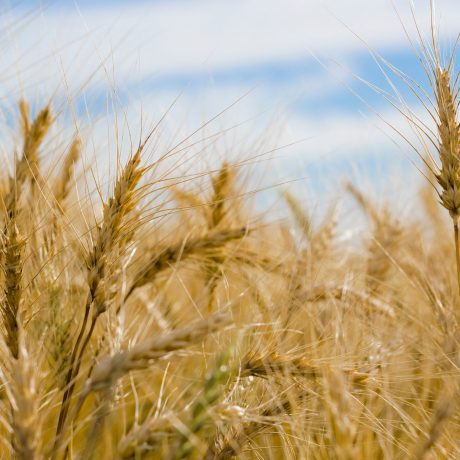The Key word for Fungicide Selection will be ‘Appropriateness’
Jock Willmott
Apr, 24 2021Soil conditions at the start of the month have been conducive to getting the last of the combinable crops drilled, so concluding the 2020/21 eight-month drilling window.
Cereal Crop Development: Cereal growth stage feels slightly behind where it should be, probably as the majority of winter cereals are drilled slightly later than desired and spring air and soil temperatures (temperature drives development – day length drives crop growth) have cooled through March. That said, growth stage in winter wheat varieties varies from emerging (2 leaf after sugar beet) to GS 31. Winter barley is having its T1 fungicide and only lately started to pick up after the wet winter, winter rye on the lighter land has started to motor and winter oats feel a little lack luster.
Wheat crops that are sufficiently forward especially where there is established yellow rust will have had/will have a Tzero including tebuconazole and growth regulator while in some situations we will be testing the varieties early rust rating and just applying a growth regulator/herbicide.
Nitrogen Applications, have generally progressed well with the trend of front loading higher rates earlier continuing. Oilseed rape, winter barley, rye have all received their final split. Total nitrogen rate has remained as planned, tweaking +/- 20kg/ha here and there depending on how well the crop has established.
Pre-January planted winter wheat crops have had two applications of nitrogen totaling c.150kg/ha, ideally timing the final dose to coincide with a rain event later this month. Final total nitrogen dose is unlikely to be too different from what was planned. The intention will be to push the best wheats especially if the performance of late planted wheat is likely to be compromised. For both first and second feed wheats this is typically 230– 240kg/ha of total nitrogen. Total nitrogen rates for milling wheats are similar but influenced by the varieties ability/potential to yield and acquire grain protein, potentially adding another 30 – 60kg/ha of nitrogen to the final split prior to any late foliar nitrogen applications.
Post January planted winter varieties of wheat are generally in a similar position but may have not had the same quantity of nitrogen to date and clearly there is a longer window to get the final dose applied. Again, ideally timing the application to the proximity of rain will be comforting. Final dose of nitrogen will be guided by rainfall and crop potential.
Tzero – T1 Growth Regulation: Having been bitten by two previously dry springs affecting early season biomass growth, rates of growth regulator at Tzero are generally cautious, with either very low doses of Moddus/3c or just 3C on its own. Many late planted unrolled crops were rolled the end of March will have reduced natural apical dominance and will not need the same rate of growth regulation at this timing.
In general, while the lack of rain persists, better to go easy at Tzreo and higher rates at T1 if conditions are warmer and wetter. Winter barley and Rye have a habit of biting back from low rates of early season growth regulator so please plan on an additional pass pre T2 if this could be the case.
Tzero – T1 Fungicide Applications: With such a range of growth stages, disease scenarios and crop potential, appropriateness will be the word of the season for fungicides.
Crops yet to have a Tzero are likely to race through to leaf three emergence so if they escape yellow rust they may well go straight to a T1 application of fungicide. With a large proportion of Jan – March planted winter wheat being Skyfall, it is likely yellow rust will require treatment before leaf three emerges but there will be some flexibility in this timing.
Wheat crops that emerged before the end of October generally have plenty of Septoria infection on the lower leaves, on both the dead leaves the frost killed but also on green leaves. With a healthy dose of inoculum already established in the early crops there is a reasonable risk from disease to these crops. The appropriateness of fungicide dose will be guided by the varietal resistance to Septoria and amount of rainfall leaf three is exposed to in the run up to treatment. As most fungicides move to the leaf tip and not towards the stem, leaf three should be 75 – 80% emerged before starting T1 applications to ensure effective protection of the leaf.
The general outlook for the month is dry which should not only reduce disease spread but also help in timely spray applications. Leaf three is emerging on the most forward wheat crops, which will likely start to receive T1 fungicide sprays from the 19th of April.
Many of the T1 options are now Prothioconazole based which is a great start for controlling stem based diseases. 1.0/lha of Ascra Xpro can be a default T1 option for an early drilled susceptible wheat variety @ c. £35/ha providing a robust level of Septoria protection with a level of disease eradication. If yellow rust remains a concern at T1 there are plenty of Prothio containing mixes such as Elatus, Firefly and Sparticus that will provide enhanced rust control at the slight expense of Septoria eradication activity. Alternatively adding a 85 – 125g/ha of Tebuconazle will clear out any established rust leaving the Ascra to provide the protection to flag leaf timing.
If other treatment options are compared against this level of control/cost it provides a useful benchmark for comparison. KWS Extase is unlikely to warrant this level of disease control so there will be opportunities to either substitute for cheaper alternatives or reduce product rates.
This same will go for the late planted wheats, with less biomass the crop has less inherent risk from Septoria but this could quickly change with a wet end to April or delayed T1 applications. Needless to say the yield potential of some of these crops may not be high so while we will have to watch the costs, disease in the crop will not help margins either.
There is much debate and opposing positions on the inclusion of Folpet (Arizona) in with the main fungicide actives. As Folpet is not as active on Septoria as Chlorothalonil and is 50% more expensive, its value in a program can be questioned especially as it does little on any other wheat diseases. It is however a different mode of action and when programs are under pressure probably due to high rainfall scenarios it is likely there will be some comfort in its inclusion in the program, particularly at T2. Trial results rarely show a negative effect to the inclusion of Folpet, the positive yield affect of inclusion can be inconclusive especially in dry conditions.
For this season it is best to have a pragmatic approach to Folpet, disease control with the potential of weather extremes, resistance development and new actives being released is a very dynamic situation and its generally better to have options available than not.
Making the call on disease risk and fungicide programs can be subjective. This season Bayer Crop Science has launched an in season, Rapid Disease Detection service for cereal disease which will give an insight into levels of disease in the leaf pre treatment. This may be quite useful and worth investigating especially if wishing to establish more about the robustness of varietal resistance in your specific region and growing scenarios. To register and find out more please follow this link. https://cropscience.bayer.co.uk/registerinterest/
Broad Leaved Weed Control: In general crops that received a pre emergence and autumn residual follow up herbicides are generally clean from broad leaved weeds at the Tzero timing. Odd charlock, fumitory, volunteer rape are appearing with cleavers generally yet to emerge. If weeds are visible by the time the crop is due for its first growth regulator, then these weeds should be controlled at this timing to reduce the tank mix at T1. If very few weeds have emerged at T0 then weed control can be left to T1 in wheat. Other cereals where a Tzero may not be necessary the timing of the broad leaved weed spray will have to fit it with other passes again aiming to keep tank mixes as limited as possible especially if conditions are dry and crops are stressed.
Wild oat, brome, volunteer cereal control: Its inevitable when walking fields thoroughly there will be patches of winter germinated brome that will come to light, plus spring germinating brome species have been emerging since the beginning of March. If brome is discovered, it is important the species is identified and the appropriate treatment applied as not all treatments may control the species in question. Most SU herbicide treatments for brome will pick up wild oats too except for Monitor. Brome herbicide options can be harsh on crops and even if applied within the label growth stage requirements so there must be cost /benefit approach in deciding to treat. There is nothing that can be done in winter or spring barley or oats to control emerged brome, in rye and spring wheat there is Broadway Star with concessions on rate.
For the most part winter and spring emerging wild oats can be controlled with Axial Pro which is becoming more reliable than Topik. Small oats are easier to control than large oats and control is generally better if applied earlier in the season when there is more moisture. Be mindful of intervals with SU herbicides and again if conditions are dry smaller tank mixes will help the crop.
SU herbicides applied to incidentally control barley volunteers in wheat have generally slowed the barley aided by the frosts and allowed the wheat to get ahead and reduce the biomass of the barley. The barley is far from all dead and will unpredictably regrow so a follow up treatment may be required.
Barley Yellow Dwarf Virus: It is evident while walking fields and driving round BYDV is appearing to a greater or lesser extent in the early emerging – presumably late/unsprayed cereals, winter barley probably showing the most signs as it is generally drilled earlier than oats and most wheats.
There is little that can be done now. Zinc applications have some effect on virus multiplication within the plant but at this stage this a little tenuous. Practically the positive management steps that can be taken is to be aware of it and make regular assessment of its extent within the crop. If it is widespread then it will influence yield and it is probably worth tailoring late season inputs accordingly. Not putting the crop under undue stress though spraying or delayed inputs will help.



